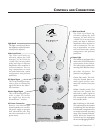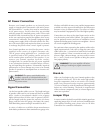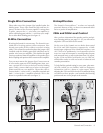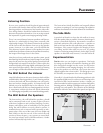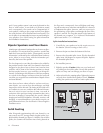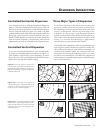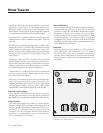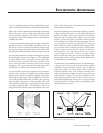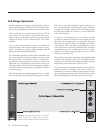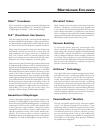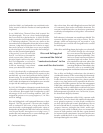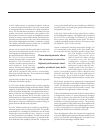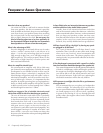
Your Summit’s launch a 30 degree horizontal dispersion
pattern. This horizontal dispersion field gives a choice of
good seats for the performance while minimizing inter-
actions with side walls (see figure 10). Make sure both
speakers stand exactly at the same vertical angle, otherwise
the image can be skewed or poorly defined. The wave
launch of both speakers is extremely accurate in both the
time and spectral domain. Consequently, small refined
adjustments can result in noticeable sonic improvements.
Controlled Vertical Dispersion
As you can see from the illustrations, your Summit speak-
ers project a controlled dispersion pattern (see figure 11).
Each Summit is a 44 inch line source beginning 15 inches
above the base. This vertical dispersion profile minimizes
interactions with the floor and the ceiling.
It is a known fact that as the sound wave becomes pro-
gressively smaller than the transducer producing it,
the dispersion of that wave becomes more and more
narrow, or directional. This fact occurs as long as the
transducer is a flat surface. Large flat panel speakers
exhibit venetian blind effects due to this phenomenon.
This is one reason why many manufacturers opt for small
drivers (i.e. tweeters and midrange) to approximate
what is known as a point source wave launch.
Historically, most attempts to achieve smooth dispersion
from large flat panel transducers resulted in trade-offs.
After exhaustive testing of many different methods, we
conceived an elegantly simple, yet intensely hand craft-
ed process. By curving the radiating surface, we create
the effect of a horizontal arc. This allows the engineers at
MartinLogan to control the high frequency dispersion pat-
tern of our transducers.
Three Major Types of Dispersion
Figure 6–7. As can be seen here, point source
concepts invite a great deal of room interaction.
While delivering good frequency response to a
large listening audience, imaging is consequently
confused and blurred.
Figure 8–9. Even though they suffer from
“venetian blind” effect, angled multiple panel
speakers can deliver good imaging, but only
to specific spots in the listening area.
Figure 10–11. A controlled 30 degree cylindri-
cal wave-front, a MartinLogan exclusive, offers
optimal sound distribution with minimal room
interaction. The result is solid imaging with a
wide listening area.
Controlled Horizontal Dispersion
Dispersion Interactions 15
DISPERSION INTERACTIONS



